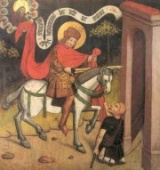St Martin of Tours

Born in 316 in Hungary, Saint Martin was one of the most popular saints of the Middle Ages. His father was a pagan officer in the army, and as a young man, Martin joined up as a conscript. However, he had already come under the influence of Christianity, and realised that the military life was not compatible with his faith.
St Martin was probably one of the earliest conscientious objectors. He made a protest, refused to fight and lived through one war in prison. At the end of hostilities in 357 he was released. At Amiens he cut his cloak in half - giving it to a poor beggar. After that he was baptised and travelled to Pannonia, Milan and Illyricum.
In 360 he became a monk and was one of the pioneers of western monasticism. In 372 he was made bishop but continued to live in his monk's cell first at the cathedral in Tours and then at the monastery of Marmoutier. During his long life he established many religious communities and travelled around his diocese by donkey, boat and on foot, preaching and healing. He developed a reputation for being a wonder worker. After his death on this day in 397 the cathedral became a centre for pilgrimage. Five hundred village churches and 4,000 parish churches have been dedicated to him.
He is depicted in many churches across Europe. In England the most complete cycle in stained glass is at St Martin's church in York, Chalgrave in Bedfordshire and Nassington in Northants. His emblems are either a globe of fire - seen over his head while he said Mass, or a goose - whose migration coincides with his feast.












